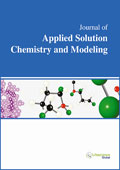jascm
Abstract : A Preliminary Study on the Removal of Methylene Blue from Aqueous Solution using Moringa Pods as Bioadsorbent under Column Operation
|
Abstract: Moringa pods (MP) was used as bioadsorbent to remove methylene blue (MB) from aqueous solutions under fixed-bed column operation. The bioadsorbent was analyzed by Fourier transform infrared spectroscopy (FT-IR) and scanning electron microscopy (SEM). Surface area (Brunauer-Emmet-Teller) and point of zero charge (pHPZC) were determined. In this study, pH influence (2.0 to 10.0) was evaluated, keeping constant conditions of bed height (11.0 cm), bioadsorbent dose (2.0 g), dye concentration (20 mg L-1), volume (25 mL), contact time (24 h) and room temperature. The MB concentration was determined using UV-spectrophotometry at 662 nm. The results showed that the adsorption was pH dependent. The highest dye removal occurs at pH 7.0 (˜100%). Infrared spectrum and morphological changes observed by SEM indicate the existence of bioadsorption phenomenon. An adsorption mechanism possible by intermolecular interactions was proposed. The study revealed the applicability of MP for removal of MB at low cost, efficient, eco-friendly and relatively neutral pH. Keyword: Agricultural waste, cationic dye, adsorption, aqueous system, fixed-bed<. |
Abstract : Anisotropic Fluid Phase Formed by Ionic Liquid-Crystalline Materials with Ammonium Ions
|
|
Abstract: Ionic liquid-crystalline materials (ILCMs) with ammonium ions were synthesized. Their thermal and orientational properties were studied by polarizing microscopy, differential scanning calorimetry, and X-ray diffraction (XRD). The ILCMs formed the smectic A phase on heating and cooling. A focal conic fan texture was observed in the phase. In addition, the ILCMs spontaneously formed a perpendicular alignment in the smectic A phase. The XRD patterns of the ILCMs consisted of sharp reflections in the small-angle region and broad band in the wide-angle region in the smectic A phase. Keywords: Anisotropic Fluid, Ionic Liquid Crystal, Thermal Stability, X-ray diffraction. |
Abstract : Multiplexing in Multi-Reflecting TOF MS
|
|
Abstract: The paper presents an overview of original inventions, development and experimental results by the group of authors in the area of multi-reflecting time-of-flight mass spectrometry with Folded Flight Path (FFP®) (MR-TOFMS) with main focus on multiplexing methods for improving the analysis throughput, i.e. the amount of information per time unit. MR-TOF provides panoramic spectra (virtue of TOFMS), while significantly enhancing resolving power, thus, providing yet more information. Resolving power R=500,000 is demonstrated to resolve isobars and to improve mass accuracy to sub-ppm level. Encoded Frequent Pulsing (EFPTM) method improves sensitivity, expands dynamic range and opens multiple incarnations of parallel and fast tandem methods of analysis based on using ion traps, TOFMS and ion mobility for rapid and lossless parent ion separations. Keywords: Multi-reflecting TOF, multiplexing, N-dimensional separations, high throughput. |
Abstract : Enhanced Eosin Mineralization in Presence of Au(III) Ions in Aqueous Solutions Containing TiO2 as Suspension
|
|
Abstract: Photo-catalytic mineralization of eosin in aerated 0.1% (w/v) TiO2 suspended aqueous systems with and without Au3+using 350 nm photo light was carried out. Eosin mineralization rate was significantly faster in 2´10-4 M Au3+ containing systems in contrast to sole TiO2 systems, which is due to the participation of Au3+ and it’s in situ generated various reduced intermediates including gold nanoparticles during mineralization. Furthermore, pulse radiolysis (a well known transient measurement technique) was adopted to analyze the reaction intermediates (eosin-OH adducts and/or eosin radical cation) produced in mineralization by generating in situ ·OH and N3· species. The reaction rates for ·OH and N3· reactions with eosin evaluated respectively 5.4´109 and 3.0´109 dm3 mol-1 s-1 for the formation of radical cations were slower than the eosin-OH adduct formation rate (reaction rate = 1.4´1010 dm3 mol-1 s-1). Furthermore, it is proposed that the initially generated eosin-·OH/hole adduct is undergoing mineralization in the presence of air/oxygen. Keywords: TiO2, Photolysis, Au(III) ions, Eosin, Gold nanoparticles, Mineralization. |






















